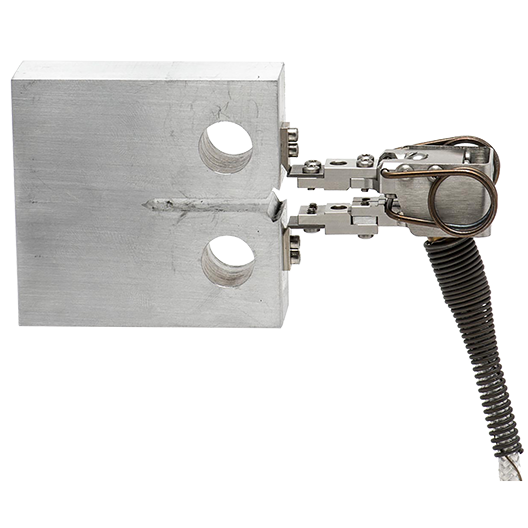700°C High-Temperature Un-Cooled Crack Opending Displacement (COD) Gage for Environmental Chambers Series 7641
The 7641 Models of High-Temperature Extensometers are perfect for the determination of fracture mechanics parameters such as JIC, KIC, R-curve, fatigue crack growth rate (da/dN) at elevated temperatures inside environmental chambers. These units may be used for strain controlled tests such as JIC.
These extensometers use a high-temperature capacitive sensor with the ability to withstand high temperatures without any cooling up to maximum temperature limit.
The 7641 COD gages introduces several improvement for uncooled, axial extensometers for testing to standards such as E1820, E399, E647 including:
- A new body style to optimize mechanical performance and reduce weight and size
- A new probe design that also provides many improvements including lower noise, better frequency response, improved flexibility and durability
- Increased operational temperature
- The ability to store calibrations of multiple extensometers with one signal conditioner
All units can be displaced slightly in compression for ease of installation.
The extensometer come standard with a freestanding sensor conditioner unit providing an electric calibration 0-10 V signal output with exceptionally low noise that can be connected to the strain channel of the controller of the testing system. This conditioner system provides several functional enhancements, including high speed digital output, built in calibration and tare functions, analogue and digital filters, and more.
Features
- Can be left on through specimen failure
- Standard configurations meet ISO 9513 class 0,5 and ASTM E83 class B-1 requirements for accuracy.
- Improved performance at high temperature
- Improved noise rejection, resolution and accuracy
- Reduced size and weight, and improved high frequency performance
- All standard models are suitable for cyclic testing ≥25 Hz is typical for 10 mm gauge length and larger, up to 100 Hz for some configurations Typically limited by the testing installation and filter selection
- Conditioner and power supply included. Provides high level DC voltage output with low noise. Easily interfaced to test controllers, data acquisition boards and chart recorders.
- Includes high speed analogue and digital outputs
- Intuitive web-based user interface for setup, calibration, and data acquisition
- Built-in calibration reference and auto-zero features
- Multiple extensometer calibration files may be loaded for use with one controller
- Multiple temperature-specific calibrations may be stored
- Selectable analogue and digital filter options from 2 Hz to 3 kHz - Ships fully calibrated with electronics with user specified voltage output (traceable to NPL)
- Mechanical over-travel protection
- Durable stainless steel knife edges
- Analog Output: User specified, ±5 VDC or ±10VDC typical, ±10.8VDC rail
- Digital Output: 24 bit high speed Ethernet output with built-in web interface
- Linearity: 11 point linearization, ≤0.1% FS typical linearity
- Resolution: <55 PPM (0.006%FS) RMS @ 4 kHz, <6 PPM (0.0006%FS) @ 100 Hz
- Analog Filter: Selectable 100 Hz analog and 2 Hz – 3 kHz digital filters
- Temperature Range: Ambient to 700 °C (1300 °F). Use up to 800 °C is possible – contact us for details. Wire forms may require periodic adjustment or replacement after long-term testing above ~600 °C.
- Temperature Sensitivity (Gain): <100 PPM / °C (0.01%FS/°C) typical
- Temperature Sensitivity (Offset): 20 PPM / °C (0.002%FS/°C) typical
- Sensor Cable: 0.7 m (2.5 ft) tri-axial high temperature cable, plus 1.5 m (5 ft) room temperature extension cable
- Operating Force: 1-5 kg typical, depending on model
- Environment: Recommended for elevated temperature testing in dry air or inert / non-corrosive gases

